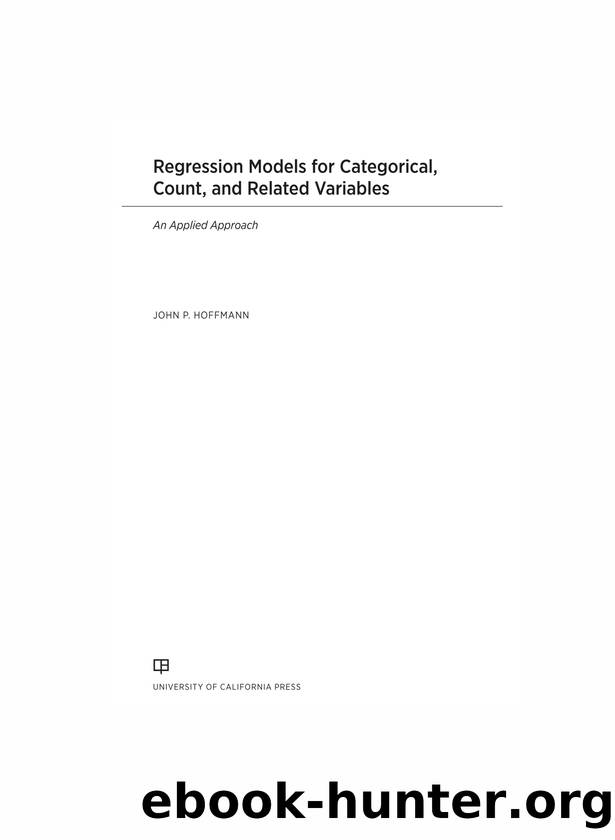Regression Models for Categorical, Count, and Related Variables: An Applied Approach by John P. Hoffmann

Author:John P. Hoffmann
Language: eng
Format: epub
Publisher: University of California Press
EVENT HISTORY MODELS
A second general type of model concerns the timing of events. For instance, medical researchers are often interested in the effects of certain drugs on the timing of recovery among a sample of patients. In fact, these statistical models are most commonly known as survival models because biostatisticians, epidemiologists, and other medical researchers often use them to study the time between the diagnosis of a disease and death, or between therapeutic intervention and death or recovery.
Social and behavioral scientists have adapted these types of models for a variety of purposes. Under the term event history analysis or duration analysis, sociologists, political scientists, and economists are interested in issues such as the following: among those who have divorced, what is their average length of marriage? What is the average length of a war (from declaration to cessation) and can we predict this based on some set of explanatory variables? What is the average length of one’s first job? Does this affect the average length of one’s second job or the probability that one changes jobs in the future?
Event history models have been developed to explicitly address these and similar questions. They are a particular type of longitudinal analysis that focuses on predicting when or how long until an event, or multiple events, occurs (Allison, 1995). Thus, the outcome variable in an event history model quantifies the duration of time one spends in a state before some episode takes place (Box-Steffensmeier and Jones, 2004). Events include transitions such as those mentioned earlier (e.g., job change) as well as death, birth, heart transplant, marriage, completing graduate school, or one’s first delinquent act. Many events, birth and death being notable exceptions, can occur more than once. A person can commit delinquent acts continuously in each month; a person might get married several times; or a person may have several jobs over a 40-year employment career.
A key for event history models is identifying when the event occurred. Sometimes one can be very specific (Samuel died on September 14 at 5:16 p.m.), although often we have to place the event into a particular time interval (Sally had her first baby in 2007). This distinction is important because it gives rise to two types of event history models: continuous-time models and discrete-time models. In continuous-time models the researcher assumes that the event can occur at any time, but, as with continuous variables, we often have to approximate this. Discrete-time models assume that the event can occur only within distinct time units. Practically speaking, discrete-time models are often used to approximate continuous-time models, such as if we wished to model what predicted the length of time until one’s first marriage, but we had only annual data on a set of individuals (see Yamaguchi, 1991, Chapters 2 and 3). We return to this issue later.
But why not simply create a continuous variable that measures the time until some event occurs (e.g., 5 months passed between the time Jessie was married and her first child was born) and
Download
This site does not store any files on its server. We only index and link to content provided by other sites. Please contact the content providers to delete copyright contents if any and email us, we'll remove relevant links or contents immediately.
| Applied | Geometry & Topology |
| History | Infinity |
| Mathematical Analysis | Matrices |
| Number Systems | Popular & Elementary |
| Pure Mathematics | Reference |
| Research | Study & Teaching |
| Transformations | Trigonometry |
Modelling of Convective Heat and Mass Transfer in Rotating Flows by Igor V. Shevchuk(6406)
Weapons of Math Destruction by Cathy O'Neil(6215)
Factfulness: Ten Reasons We're Wrong About the World – and Why Things Are Better Than You Think by Hans Rosling(4713)
A Mind For Numbers: How to Excel at Math and Science (Even If You Flunked Algebra) by Barbara Oakley(3256)
Descartes' Error by Antonio Damasio(3248)
Factfulness_Ten Reasons We're Wrong About the World_and Why Things Are Better Than You Think by Hans Rosling(3216)
TCP IP by Todd Lammle(3154)
Fooled by Randomness: The Hidden Role of Chance in Life and in the Markets by Nassim Nicholas Taleb(3080)
Applied Predictive Modeling by Max Kuhn & Kjell Johnson(3041)
The Tyranny of Metrics by Jerry Z. Muller(3028)
The Book of Numbers by Peter Bentley(2928)
The Great Unknown by Marcus du Sautoy(2662)
Once Upon an Algorithm by Martin Erwig(2621)
Easy Algebra Step-by-Step by Sandra Luna McCune(2604)
Lady Luck by Kristen Ashley(2554)
Police Exams Prep 2018-2019 by Kaplan Test Prep(2516)
Practical Guide To Principal Component Methods in R (Multivariate Analysis Book 2) by Alboukadel Kassambara(2512)
All Things Reconsidered by Bill Thompson III(2371)
Linear Time-Invariant Systems, Behaviors and Modules by Ulrich Oberst & Martin Scheicher & Ingrid Scheicher(2346)
